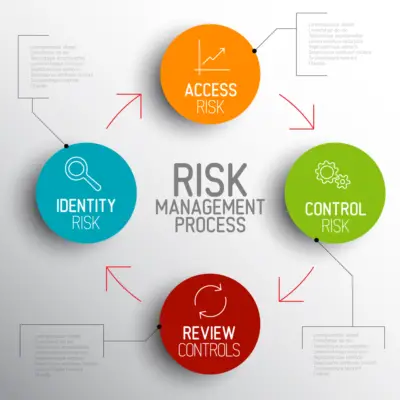In the increasingly regulated world of finance, mastering the core principles of Risk and Control Self-Assessment (RCSA) is imperative for professionals aiming for optimal compliance.
- Always start with a risk assessment (source: GAN Integrity)
- Understand the latest enforcement policies (source: GAN Integrity)
- Manage compliance risk with third parties (source: GAN Integrity)
- Make it easy to find the right courses for training employees (source: Relias)
- Automate course reminders for employees (source: Relias)
- Create smart and effective compliance policies (source: Relias)
- Be consistent with risk management and leverage your work in your business decisions to get the most value (source: Ncontracts)
Delving into the aspects of this key risk management component, we’ll navigate through the fundamentals of RCSA, its impact on financial compliance, and its crucial role in risk mitigation.
Furthermore, we’ll delve deep into the thriving inside of the RCSA process and elucidate how financial institutions can integrate it meaningfully and effectively into their operational framework for outstanding risk management outcomes.
Understanding the Basics of RCSA
While you navigate the complex landscape of financial services, you’ll often come across terms and concepts that may seem puzzling.
Among these many acronyms, RCSA, or Risk Control Self Assessment, shines out significantly because of the critical role it plays in financial compliance.
Understanding RCSA: The Cornerstone of Risk Management
In simple terms, RCSA is an empowering tool for businesses, a key process where businesses evaluate their own risk and control metrics. Implemented as an efficient mechanism of proactive risk management, it helps businesses to identify, assess, control, and manage potential risks that they may encounter in their operations.
One remarkable aspect of RCSA is that it goes beyond simply cataloging potential risks. It pushes the boundaries and serves as an introspective mirror helping organizations to evaluate the effectiveness of their controls and processes in place, thus promoting a culture of responsibility and proactivity.
RCSA is structured and systematic, encouraging businesses to think strategically about risks and controls, like a seasoned chess player thinking multiple steps ahead.
Why RCSA is Critical in Financial Compliance
Today’s financial world is an intricate, detail-oriented, and immensely regulated environment. The compliance framework has transected borders, and global standards of operation necessitate stringent risk management tactics. Here, RCSA plays the role of a vigilant gatekeeper.
One significant aspect of RCSA that positions it at the heart of financial compliance is its ability to bolster a company’s Internal Capital Adequacy Assessment Process (ICAAP). It helps businesses meet the regulatory requirements of Basel II by enhancing the precision and reach of their risk assessments.
Furthermore, RCSA enables organizations to stay a step ahead of potential risk. With RCSA, organizations can identify and manage risks before they materialize, thereby aiding in swift resolution.
This proactive approach is critical in preventing regulatory breaches and ensuing penalties, which can amount to considerable financial and reputational loss.
Finally, demonstrating a robust RCSA process can reassure regulators, investors, clients, and partners about an organization’s knowledge of its risk landscape and its commitment to managing those risks effectively.
This provides a competitive advantage and supports financial stability, making RCSA a crucial aspect in bounding towards the finish line, winning the race called financial compliance.
To sum up, RCSA is not just a process but a strategic armor, an empowering tool for financial organizations to navigate the sophisticated terrains of regulatory norms and compliance.
It’s mandated by regulators, loved by analysts, and glorified by companies that understand its true potential.
With the ever-evolving landscape of financial services, having a resilient, proactive risk management strategy like RCSA is no longer a choice. It’s a necessity born out of the need to stay compliant, competitive, and sustainable.
The challenge to stay relevant, survive, and thrive in this ever-evolving business environment is an arduous journey. But with tools like RCSA, you’re well-armed to turn potential risks into en-route milestones!

In-Depth Look at RCSA Process
Unveiling the RCSA Process: A Methodical Pursuit of Operational Excellence
Delve one layer deeper into the world of Risk Control Self-Assessment (RCSA) and discover how this comprehensive process assists businesses in circling potential risks and proactively formulating responses.
By conducting a thorough scrutiny of an organization’s workflow, RCSA captures a panoramic view of prospective hurdles and ensures the possible setbacks are held at bay. No stone is left unturned; no contingency is left unexamined.
The initial phase of RCSA revolves around the pro forma identification of risks. This involves categorizing risks that may jeopardize the organization’s ongoing operations and long-term objectives – the likes of strategic, financial, operational, and legal risks.
The process calls for immense expertise, as the accurate recognition of risks paves the way for proper control measures to be placed.
Next enters the phase of risk analysis, an intensive procedure designed to evaluate the frequency of potential risks and their associated impact. This stage requires a firm grip on both quantitative and qualitative data.
Simultaneously, it is essential to stay vigilant about the ever-evolving business landscape and adjust risk assessment models accordingly. RCSA blends statistical data with managerial judgment to harvest precise risk estimates, which are essential markers guiding the way forward.
The crucial process of risk monitoring follows suit. This step involves the rigorous observation of risk patterns and tracking any deviations from projected behavior.
The intention here is prompt detection of any fluctuation in risk elements. Thus, an effective monitoring mechanism should be powered by real-time data and advanced analytics, ensuring a swift retort to any unexpected turns.
The umpteenth yet critical aspect woven into RCSA is control assessment. In this stage, organizations ascertain the effectiveness of the controls implemented to address impending risks.
Are they effective? To what degree? Have the controls managed liabilities as anticipated, or have they fallen short? Control assessment paves the route to enhanced implementation strategies by extracting lessons from existing approaches.
A key component to the success of a fully functional RCSA machine is the staff’s adequate training. Employees at all levels must possess an apt understanding of the RCSA regimen.
Moreover, the organization should foster an open communication culture, making sure that identified risks and control measures are shared across all departments for seamless operation.
RCSA is not a one-time event. Instead, it is an ongoing process that incessantly fuels the corporate decision-making machinery. Regularly updating the RCSA process considering updated laws, market trends, and potential operational changes, can drastically improve the effectiveness of the framework.
In the same vein, frequent evaluations and modifications of the RCSA program according to the evolving industrial milieu are mandatory to stay the course.
In conclusion, the power of RCSA extends far beyond its immediate attributes. It embodies a holistic, proactive, and methodical approach to managing risks, becoming an indispensable asset to businesses looking to ride out potential risks without faltering.
By harnessing the process of RCSA, organizations not only shield themselves from conceivable obstacles but also gain a competitive edge, ensuring corporate resilience and long-term success in an increasingly unpredictable business environment.

Developing Effective RCSA Frameworks
Now that we’ve covered the essence of RCSA and its myriad benefits let’s delve into concrete steps financial institutions can take to build effective RCSA frameworks.
An effective RCSA program requires more than just a clear understanding of the concept and its potential advantages. It demands a strategic approach, meticulous planning, systematic execution, continuous monitoring, and periodic updating.
First and foremost, risk identification forms the solid foundation for any RCSA framework. It involves recognizing the possible internal and external threats that could hamper the institution’s objectives.
Beyond the standard categories — strategic, financial, operational, and legal risks — there’s a need to keep an eye out for emerging and less-prevalent risks influenced by dynamic factors like technology, geopolitics, and socio-cultural shifts.
Once identified, these risks fall under the scrutiny of risk analysis. This stage requires a delicate play between qualitative and quantitative data. While frequency and impact offer a numerical measure of risks, qualitative data elicits experiential evidence of unforeseen anomalies.
Financial institutions must refine their risk assessment models to incorporate these multi-dimensional data sources, tailoring them to their unique business landscape.
Continuous monitoring of risk components plays a vital role in establishing an effective RCSA framework. The emergence of real-time data and advanced analytics transforms this aspect, providing deeper insights into risk patterns and promptly detecting deviations.
By harnessing technology and data analytics, financial institutions can significantly increase the efficacy of their risk-monitoring process.
A close examination of the controls in place can either reinforce the trust in the collective defensive mechanisms or unveil potential vulnerabilities.
Control assessment allows financial institutions to evaluate the efficiencies of implemented controls. This workflow demands auditing skills, control testing techniques, and an understanding of risk-control linkages.
More than just a procedural compliance need, the RCSA mandates a shift in the organizational culture. Financial institutions must foster open communication, cultivating an environment where employees feel encouraged to report process gaps and potential risks.
Furthermore, the RCSA regimen should not be restricted to top management or risk professionals but must reach every employee. Hence, targeted training programs should accompany the implementation phase and continue thereafter, building a workforce that understands and abides by the RCSA’s guiding tenets.
Given the changing business landscape, adopting a one-off approach to RCSA can lead to a dated risk management plan.
For an RCSA program to remain effective, regular updating is paramount as it allows for revisions in alignment with industry advancements, regulatory changes, and internal shifts.
Structured yet flexible, the RCSA framework trains financial institutions to spot, counter, and learn from risks rather than avoid them altogether. It’s a holistic, proactive, and methodical approach to combating threats.
With these attributes, financial institutions can expect robust risk management that enables long-term success and resilience amid an unpredictable business environment.
Risk has always been an inherent part of business. However, with a well-executed RCSA framework, these ubiquitous risks transform from impenetrable barriers to surmountable challenges that pave the way for progress and prosperity in the financial realm.
To quote the wise words of businessman Elon Musk, “Failure is an option here. If things are not failing, you are not innovating enough.”

Overcoming Common RCSA Challenges
Despite its immense benefits, implementing Risk Control Self-Assessment (RCSA) comes with a unique set of challenges. Understanding these hurdles, and proposing sustainable solutions to them, is the essential next step in leveraging this powerful risk management tool for operational efficiency and financial prudence.
One of the most significant challenges faced in implementing RCSA is employee resistance. Change, as they say, is never easy. Understanding the nuances of RCSA, accepting its necessity, and learning to utilize it in everyday work tasks can be overwhelming for employees.
Companies can address this resistance with effective change management strategies. Incorporating RCSA into the organizational culture requires top-down leadership, open communication, and proper training programs tailored for employees at all levels of the organization.
Data-related issues also pose a major problem. Data collection, particularly in the initial stages of RCSA implementation, can be a mammoth task due to the sheer volume and complexity of data involved. Poor quality, missing, or outdated data can render the RCSA ineffective.
To overcome this, organizations need to employ advanced data management tools for real-time data collection and efficient analytics. It’s also crucial to establish and follow rigorous data validation procedures to ensure accuracy and reliability.
Another stumbling block is irregular monitoring and updating. A vital trait of RCSA is its cyclical nature; it is by no means a one-and-done deal.
Failing to conduct regular risk assessments and not updating the RCSA framework to reflect changes in the business landscape can lead to redundant processes and inaccurate risk forecasting.
Therefore, it’s essential to foster a diligent risk-monitoring culture within the organization, employing real-time data and advanced analytics and continually refining the RCSA process.
The inability to handle the interplay between quantitative and qualitative data is another foreseeable predicament. Utilization of solely numerical data can guarantee rigid, falsifiable projections but often lacks the nuanced understanding that qualitative accounts provide.
To achieve the best of both worlds, the RCSA model needs to incorporate hybrid data blends and allow flexibility for adjustment as conditions evolve.
Last but not least, organizations often fail to categorize risks accurately, leading to misdirected attention and resource allocation. A firm understanding of the different risk types – strategic, financial, operational, and legal – and how to prioritize them is vital for an effective RCSA process.
Trained risk officers who can identify and categorize risks, evaluate their impacts, and delineate appropriate control mechanisms are quintessential for the organization’s long-term success and resilience in an unpredictable business environment.
Despite the challenges surrounding RCSA implementation, overcoming them is achievable. By fostering a resilient organizational culture, leveraging advanced data management platforms, practicing regular monitoring and updating, refining the interplay of data types, and categorizing risks intelligently, companies can turn potential risks into opportunities for growth and innovation in the fast-paced world of business and finance.

Case Studies on Successful RCSA Implementation
While having understood the overarching concept and comprehensive features of Risk Control Self Assessment (RCSA), it is equally essential to explore the best practices and strategic approaches that leading financial institutions have adopted to implement RCSA successfully.
Tech giants like Barclays and PwC exemplify the effective execution of the RCSA framework. Barclays, for instance, starts by integrating RCSA into its overall risk management framework instead of treating it as a standalone process.
They ensure that RCSA is at the helm of all risk-related decisions, enriching strategic planning and decision-making processes.
Similarly, PwC adopted the RCSA ethos by making it essential in their day-to-day operations. They implemented a comprehensive risk assessment process with regular audits to ensure the continued effectiveness of their control measures.
The key here is the consistent effort to integrate RCSA within operational processes, thereby fostering a risk-aware culture within the organization.
Flourishing institutions take a more fluid approach by continuously evaluating their RCSA program, ensuring alignment with industry standards and changes in regulatory norms.
These institutions recognize that RCSA is not a ‘set and forget’ strategy but rather a dynamic practice that should adapt to the shifting landscapes of business, technology, and regulation.
Dealing successfully with employee resistance to implementing RCSA is another attribute common among thriving institutions.
This resistance is tackled in a multi-pronged manner, right from promoting a culture that understands and appreciates the importance of RCSA to implementing detailed training programs targeted at every hierarchy within the organization.
Moreover, in a swift resolution to data-related issues in RCSA implementation, these institutions leverage fledgling technologies like Big Data and AI to amass, analyze, categorize, and monitor risks that are otherwise challenging to identify.
They harness the power of such technologies to blend both quantitative and qualitative data, thus ensuring a comprehensive vision of risk landscape and control efficacy.
Nevertheless, successful implementation does not mean an absence of challenges. The crux is about transforming these challenges into opportunities.
Leading financial institutions exhibit this very resilience when dealing with issues like irregular monitoring or improper categorization of risks.
Rather than seeing these challenges as stumbling blocks, they approach it with a vision of continuous improvement — updating systems, synchronizing processes, and ensuring that RCSA continues to be a robust apparatus in their risk management toolkit.
Thus, successful implementation of RCSA is not just about having a thorough understanding of the process, but it also involves strategic planning, cohesive integration of processes, technological advancement, and a continual commitment to improvement.
With these tactics in play, the potential risks transmute into opportunities contributing to the long-term success and resilience of an institution in an unpredictable business environment.

Conclusion
Navigating through the complex landscape of risk management and financial compliance, we have discussed the comprehensive role of RCSA, its process, implementing effective frameworks, overcoming challenges, and successful industry implementations.
By equipping ourselves with critical insights and practical strategies, we, as financial professionals, can embrace RCSA efficaciously to identify, assess, and control risks, forming a strong backbone for financial compliance in our institutions.
To summarize, a robust RCSA process is not merely a regulatory requirement but a strategically significant tool that empowers financial institutions to build a resilient operational environment, driving them toward sustainable success.

Chris Ekai is a Risk Management expert with over 10 years of experience in the field. He has a Master’s(MSc) degree in Risk Management from University of Portsmouth and is a CPA and Finance professional. He currently works as a Content Manager at Risk Publishing, writing about Enterprise Risk Management, Business Continuity Management and Project Management.


